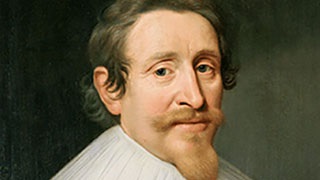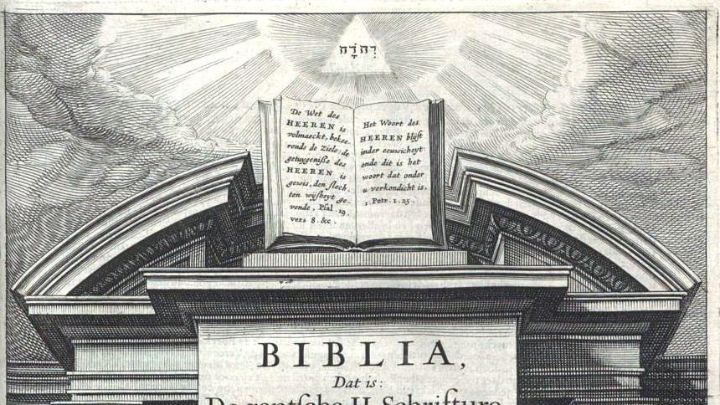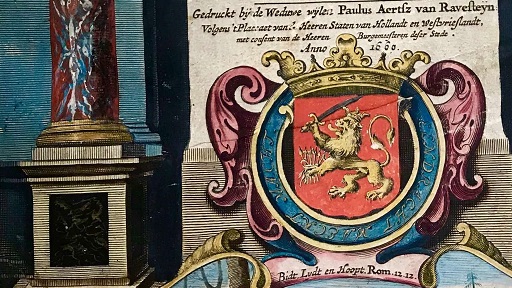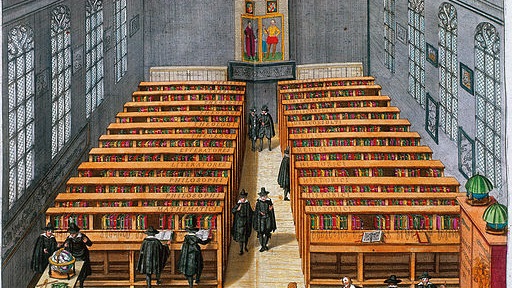About the Synod of Dordt
Digital exhibit
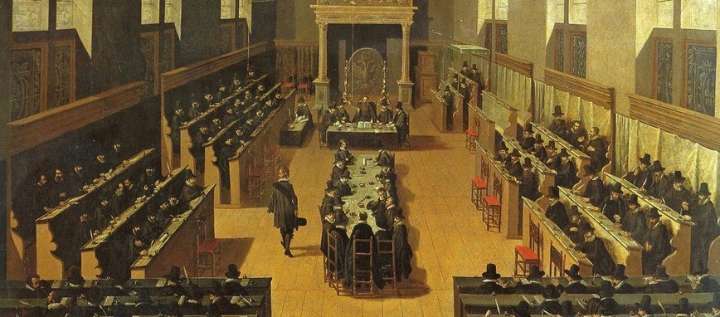
About the Synod of Dordt
- The Meeter Center for Calvin Studies at Calvin University has brought together a vast array of materials and information about the Synod of Dordt and its impact.
The Puritans and Their Impact

The Puritans and Their Impact
- Over 400 years ago, in 1620, the Mayflower brought the Pilgrims, dissenters from England, to Cape Cod. Joined by other Puritans, they established colonies along the northeastern coast of North America. The Meeter Center organized a two-day conference on September 24 and 25, 2021, to explore the complex legacy of this migration and foster discussion on the Puritans' impact.
The Meeter Center for Calvin Studies at Calvin University has brought together a vast array of materials and information about the Synod of Dordt and its impact.
Scroll down for a very short introduction to the synod. Click on the boxes below to find out more about the main participants in the synod, key dates, the synod-sponsored major Bible translation project known as the Statenvertaling, and links to further resources. We hope these pages will help individuals, churches, and other groups learn more about the synod as we commemorate the 400th anniversary of its gathering.
A (very) brief historical introduction
Synod of Dort, Dordt, or Dordrecht: which is right? In fact, all three are correct. Dordrecht is the name of the Dutch city in the province of Holland that hosted the synod. The colloquial name for Dordrecht in Dutch is Dordt. The English version of Dordt is Dort. For the sake of consistency, and to match the usage of the majority of scholars writing about the synod, we will refer to the Synod of Dordt.
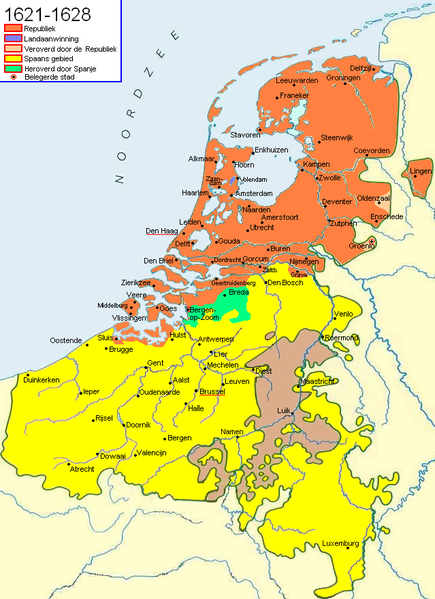 The Netherlands 1621-1628
The Netherlands 1621-1628
The Reformations of the sixteenth century led to the emergence of different confessional groups within western Christendom: Lutherans, Anglicans, Anabaptists, and Reformed believers (including Huguenots in France and Presbyterians in Scotland) each made their case for their beliefs over against Roman Catholicism and each other. But some major theological issues remained unresolved all the way up to the seventeenth century. Within the Reformed family of faith, theologians disagreed over the doctrine of election: did God will to save all, or only some from eternal damnation? Did people have free will in their decision to turn towards or away from salvation? Did God’s foreknowledge of how people would respond to the gift of salvation in Jesus Christ affect God’s decision to number them among the elect or the reprobate? In the Dutch Reformed church, this controversy crystallized in a contentious debate between two professors at the University of Leiden, Jacobus Arminius and Franciscus Gomarus. Arminius (and his supporters after his death in 1609) taught that the idea of God electing and reprobating everyone even before Adam and Eve’s fall into sin was unbiblical and left no room for God’s grace to act in human lives. His supporters issued a Remonstrance in 1610, listing their five points of disagreement with their opponents. Gomarus for his part held to a strict view of predestination and election. He and his supporters became known as the Counter-Remonstrants.
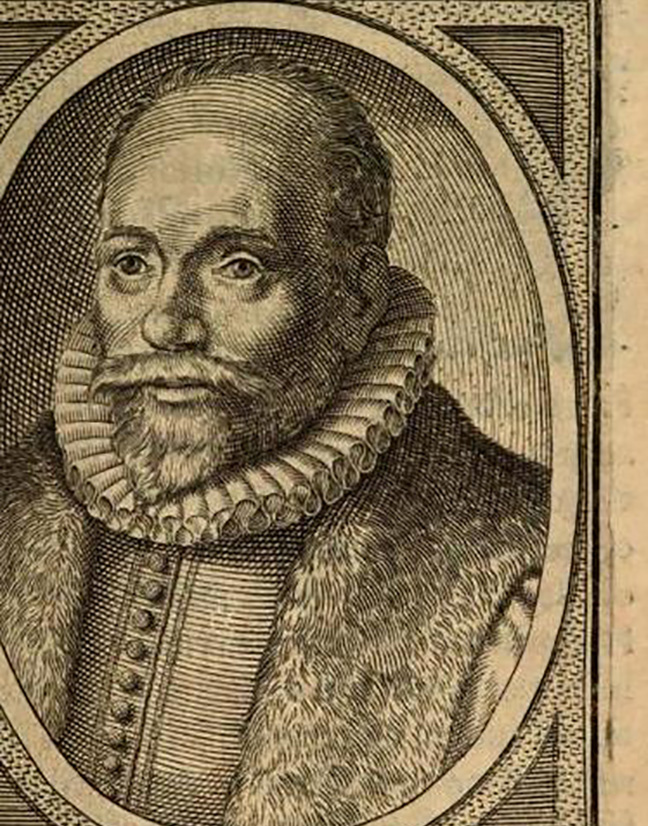
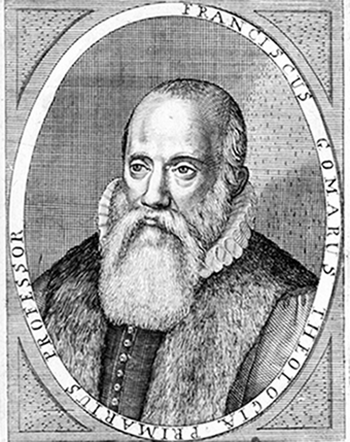
This theological controversy overlapped with a political power struggle in the Netherlands in the first decades of the seventeenth century. Two factions, one led by Prince Maurice of Nassau and the other led by the senior Dutch politician Johan van Oldenbarnevelt, vied for control of the Dutch government. Maurice of Nassau increasingly allied himself with the traditionalist Calvinist theologians (the Counter-Remonstrants), whereas Oldenbarnevelt found his support among the more liberal wing (the Remonstrants). The two groups also crucially divided over the appropriateness of state oversight and intervention in church affairs. Remember that the Reformed faith was the official faith of the Netherlands at the time, and hence the Reformed church functioned as a state church. However, the Counter-Remonstrants largely rejected what they saw as the state’s encroachment on the church, whereas the Remonstrants appealed to the state to exercise its authority over the church (and curb the pressure of their opponents).
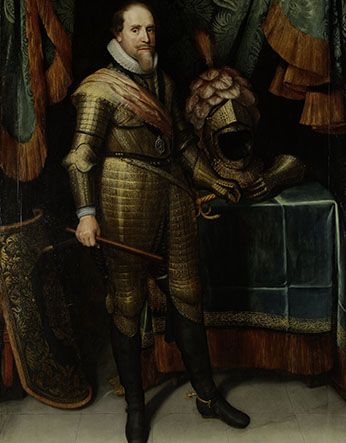
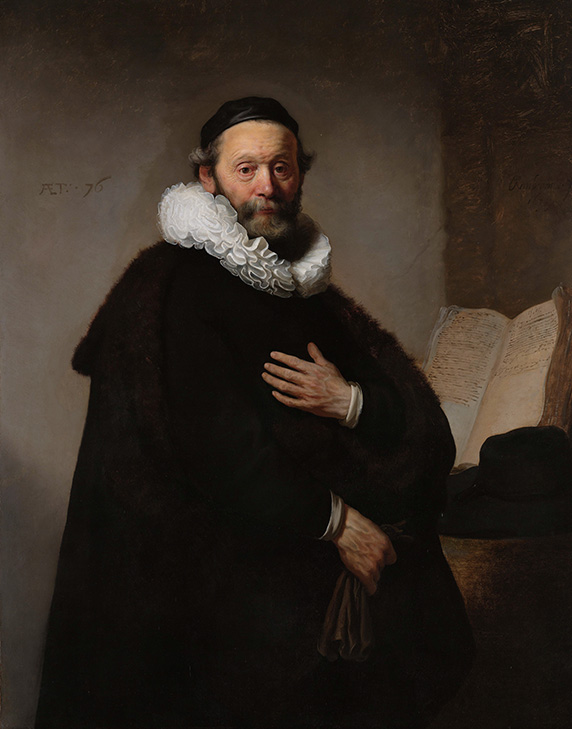
Theological debates and political pressures merged in 1618, leading the Dutch States-General (the Netherlands’ governing body) to call a national synod to resolve many of these issues. In order to give the meeting more legitimacy and impact, the States-General decided to invite Reformed delegates from other countries to join the gathering. On November 13, 1618, the Synod of Dordt began its meetings. The final session took place on May 9, 1619.
Results of the Synod
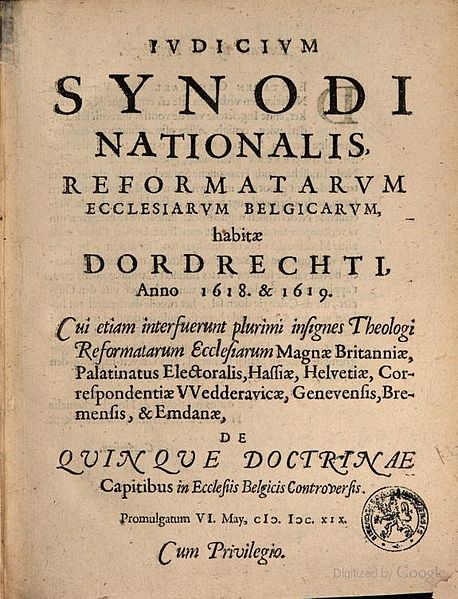 Title page of the Canons of Dordt, 1619
Title page of the Canons of Dordt, 1619
The Synod of Dordt is most well known for its theological work on election and predestination, resulting in the Canons of Dordt and the ensuing decision to dismiss Remonstrant pastors from their posts and banish them from Dutch territory. However, the Synod of Dordt also took time to address a number of other issues.
Summary of some of the Synod’s other decisions
- Baptism of non-Christian servants and slaves in the Dutch East Indies. The Synod considered whether these individuals should be baptized if their parents were not Christian. Ultimately, the delegates decided that adult servants and slaves who requested baptism and were catechized could be baptized, but that child servants and slaves who had non-Christian parents could not be baptized until they were old enough to be catechized and request the sacrament.
- Bible translation. The Synod commissioned the Statenvertaling (States Translation), the first complete Dutch Bible translation working from the original languages. In a joint effort of church and state, the Bible was funded by the States General, the governing body of the Dutch Republic.
- Catechisms and catechizing. After extensive debate, the Synod ordered three kinds of catechizing: at home, at school, and at church, and created a committee to prepare appropriate catechisms for each setting and age group, all based on the Heidelberg Catechism.
- Church order. The Synod spent considerable time after the departure of the international delegates setting up a uniform church order that would apply to all Dutch and Walloon (French-speaking) Reformed churches. The church order dealt with the roles and responsibilities of pastors, elders, and deacons, outlined the structure and operations of representative church assemblies all the way up to the national synod, provided directions for catechetical instruction and the celebration of the sacraments, and laid out the practice of church discipline. Read an English translation of this church order.
- Patronage. the Synod of Dordt recognized the continuing practice of patrons (usually members of the nobility) having the right to nominate clergy for particular churches, but laid out nine rules to regulate the practice, including allowing the patron a maximum time of two to three months to nominate a candidate for a vacancy, after which time they would lose their right to make that nomination this time round.
- Sabbath observance. The Synod of Dordt approved a set of six articles calling for people to forego work on the Sabbath, though the articles do not lay out specific provisions for how the Sabbath should be observed.
- Schools and education. The Synod of Dordt approved a series of ten articles to regulate higher education in the Dutch academies and universities. These included ensuring strong confessional oversight of the teaching faculty, preventing the professors in philosophy and languages from discussing theological topics without permission of the theology professors, and keeping theology professors from raising doubts about received doctrines or articulating new theological opinions.
- Training for student pastors. The Synod decided that those training for the ministry were not to celebrate baptisms, but that local classes and churches could decide for themselves whether or not to allow the students to preach.
Who’s Who
Learn about the major characters at the Synod of Dordt.
Learn more about some of the key participants in the Synod of Dordt.
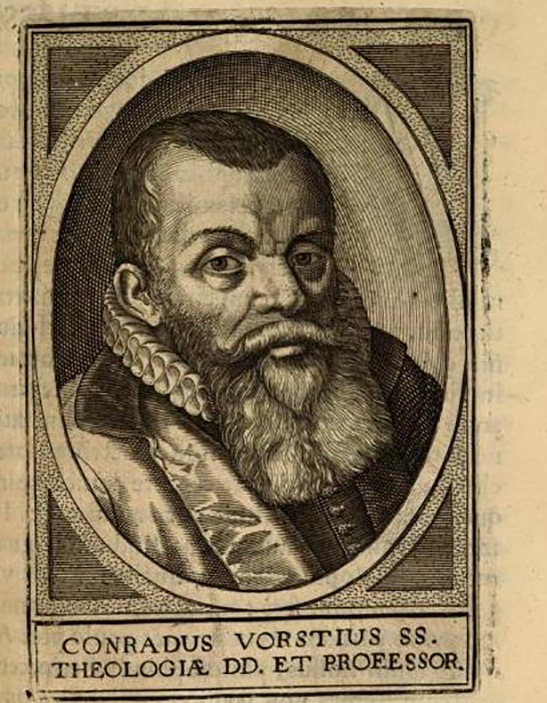
Vorstius, Conrad (1569-1622)
Born in Cologne in a Roman Catholic family, Vorstius converted to the Reformed faith and studied in Herborn, Heidelberg, Basel, and Geneva. He taught theology in the academy at Steinfurt near Münster from 1596 to 1611, when he became the successor to Jacob Arminius as professor of theology at the University of Leiden. His appointment became a flash point for controversy due to persistent accusations from orthodox Calvinists including Sibrandus Lubbertus, Franciscus Gomarus and even James I of England that Vorstius held heterodox views on fundamental Christian doctrines. His detractors accused him of Socinianism (an anti-Trinitarian stance). Vorstius’ unorthodox theology made it difficult for his Arminian supporters to defend his views, so Hugo Grotius and others concentrated instead on defending the government’s fundamental right to appoint professors to university chairs without interference from the church. As a result of the controversy, Vorstius was dismissed from his post in 1612, and in 1619 was banished from the Dutch Republic. At the time of his death in 1622 he was living in exile in the German territory of Holstein.
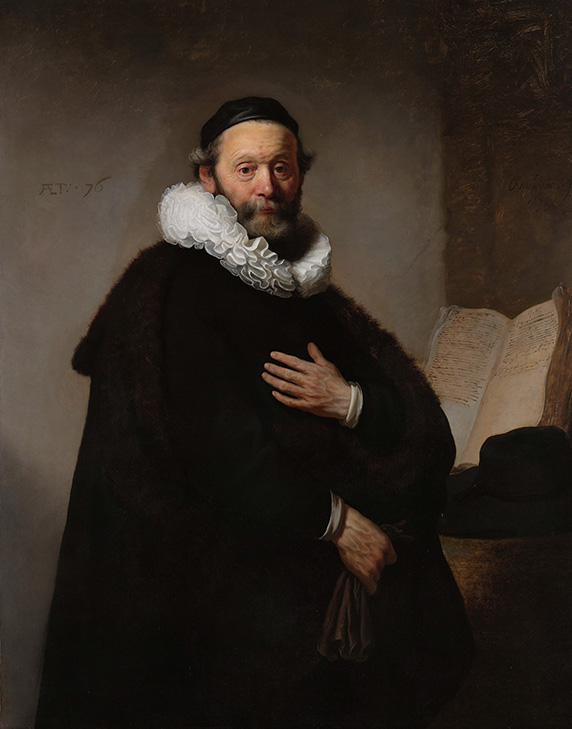
Wtenbogaert, Johannes (1557-1644)
Born in Utrecht into a Roman Catholic family, he broke with Catholicism in 1578 and went to Geneva to study theology beginning in 1580. He served as a Reformed pastor in Utrecht and in The Hague, and as court preacher and military chaplain to Maurice of Nassau. He became the leader of the Remonstrants following the death of Arminius. In 1618, following the arrests of Oldenbarnevelt and Grotius, Wtenbogaert fled to Antwerp in the Spanish Netherlands. In 1619, the States General banished him from Dutch territory. He went into exile to France, though he returned in 1626, following the death of Maurice of Nassau. From then on until his death in 1644, Wtenbogaert served as a Remonstrant pastor in The Hague.
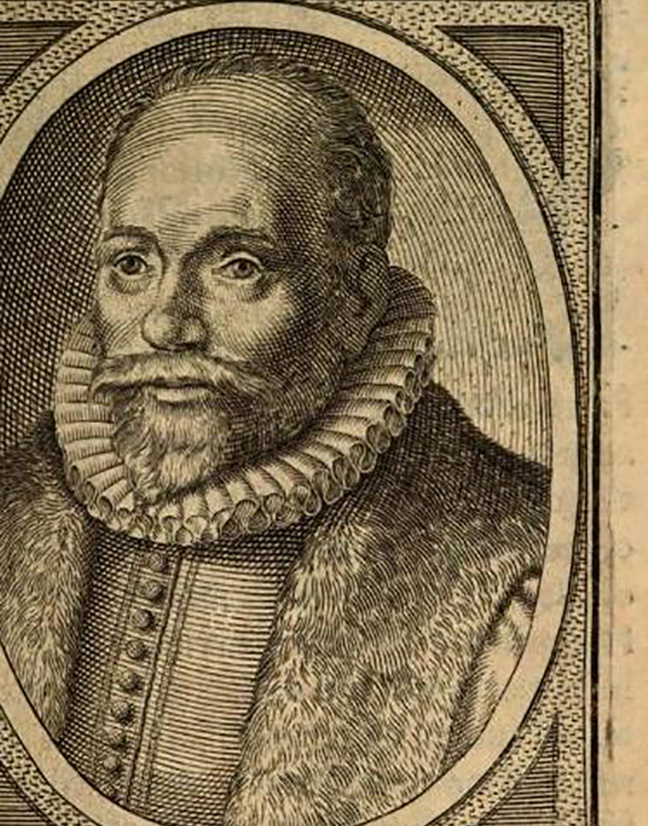
Arminius, Jacobus (1560-1609)
Born in Oudewater (province of Utrecht), he studied at the University of Leiden, at the University of Basel, and at the Genevan Academy. He became a pastor in Amsterdam in 1587 and joined the faculty of theology at the University of Leiden as professor in 1603. Both as a pastor and a professor, Arminius increasingly made public his critique of hardline Calvinist predestinarian theology. In oral debates and in print, his opponents accused him of reviving the ancient Pelagian heresy that taught that human beings had free will and could cooperate with God in working towards their salvation. Arminius rejected these charges and condemned Pelagian views. His main opponent at the University of Leiden was his colleague Franciscus Gomarus. The two men clashed repeatedly in person and in writing up to Arminius’ death in 1609. His followers and supporters later became known as Arminians (not to be confused with Armenians, who are people from Armenia in western Asia)
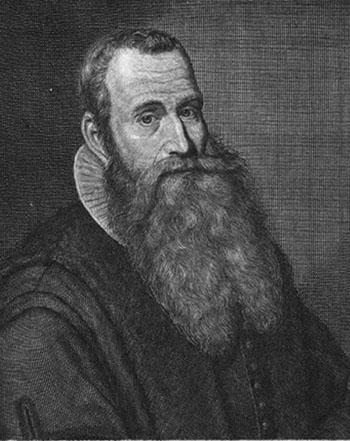
Bogerman, Johannes (1576-1637)
Born near Emden in northern Germany, Bogerman studied in Heidelberg, Geneva, and Zurich, with shorter stays in Lausanne, Oxford, and Cambridge. He became a pastor and served congregations in Sneek, Enkhuizen, and Leeuwarden. He chaired three provincial church synods in 1605, 1610, and 1615. His expertise in church government and his orthodox Calvinist perspective led him to be asked to preside at the Synod of Dordt. He contributed to the translation of the Old Testament into Dutch for the Statenbijbel. In 1636, he became professor of theology at the University of Franeker. He died there in the following year.
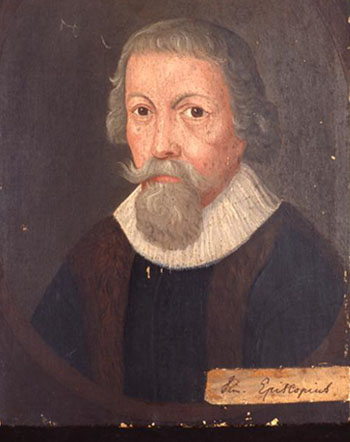
Episcopius, Simon (1583-1643)
Born in Amsterdam, he studied at the universities of Leiden and Franeker. He became a pastor in 1610 near Rotterdam and was appointed professor of theology at the University of Leiden in 1612. He attended the Synod of Dordt as the chief spokesman for the thirteen Remonstrant clergy in attendance, but the Synod refused to allow him to present the Remonstrant perspective at the gathering. By the end of the Synod, Episcopius and his Remonstrant colleagues stood condemned, were dismissed from their posts, and were forced into exile. Episcopius went to France, but returned to the Netherlands in 1626 following the death of Maurice of Nassau. He became the pastor of the Remonstrant congregation in Amsterdam and the principal of the Remonstrant college in the city.
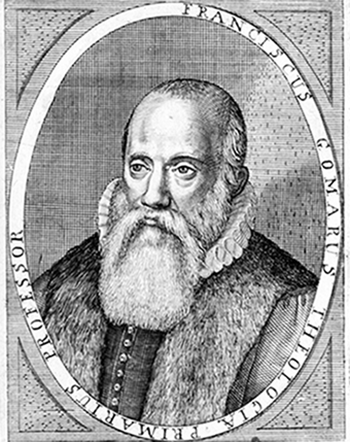
Gomarus, Franciscus (1563-1641)
Born in Bruges in the southern Netherlands, he studied in Strasbourg, Neustadt, Oxford, Cambridge, and Heidelberg. He began his career as pastor of a Dutch Reformed exile church in Frankfurt in 1587. In 1593 he became professor of theology at the University of Leiden. Although he initially approved the appointment of Arminius as his colleague, he quickly opposed what he saw as Arminius’ unorthodox teachings on election and predestination. Gomarus gained supporters for his side of the debate, later known as Gomarists. He left the university in 1611 after one of Arminius’s supporters was appointed to the faculty. Gomarus later taught theology and Hebrew in Middelburg, Saumur, and Groningen. He attended the Synod of Dordt as an academic delegate representing the states of Groningen and Ommelanden, and later contributed to the Statenbijbel.
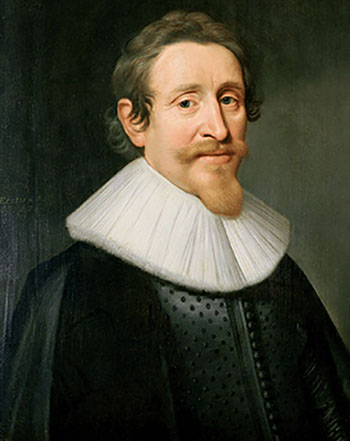
Grotius, Hugo (1583-1645)
Born in Delft, he studied at the University of Leiden, where he enrolled at age eleven. He became widely known as a legal scholar and expert, drafting an important early treatise on the concept of international waters and the freedom of the seas. He was closely associated with Johan van Oldenbarnevelt and held various high-level political positions. He supported the Remonstrant cause and wrote a defense of the government’s right to appoint professors to university positions without input from the Reformed church. In 1614 he produced an edict on religious toleration at the request of the States of Holland, calling for moderation and toleration among the pastors. His main opponent on these issues was the counter-remonstrant pastor Sibbrandus Lubbertus. In August 1618, Grotius was arrested alongside Oldenbarnevelt. Grotius was condemned to life imprisonment, but managed to escape prison in 1621 by concealing himself in a chest of books. He fled to France, where he wrote his most famous book, the three-volume De Jure belli ac pacis (on the law of war and peace). He later returned from exile and taught in the Remonstrant seminary in Amsterdam.
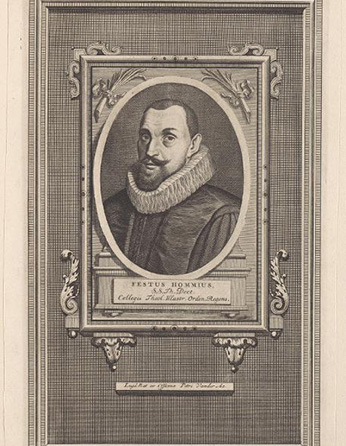
Hommius, Festus (1576-1642)
Born in Jelsum in Friesland, he studied at the universities of Franeker and Leiden. He began serving as a pastor in 1597. A strong Counter-Remonstrant, he opposed both Vorstius and Episcopius’s nominations as professors of theology at the University of Leiden. He served as one of the secretaries at the Synod of Dordt. He played an important role in the publication of the Dutch Bible translation known as the Statenvertaling, as he took over the translation of the New Testament from the deceased Peter Cornelius. He later served as one of the governors of the University of Leiden.
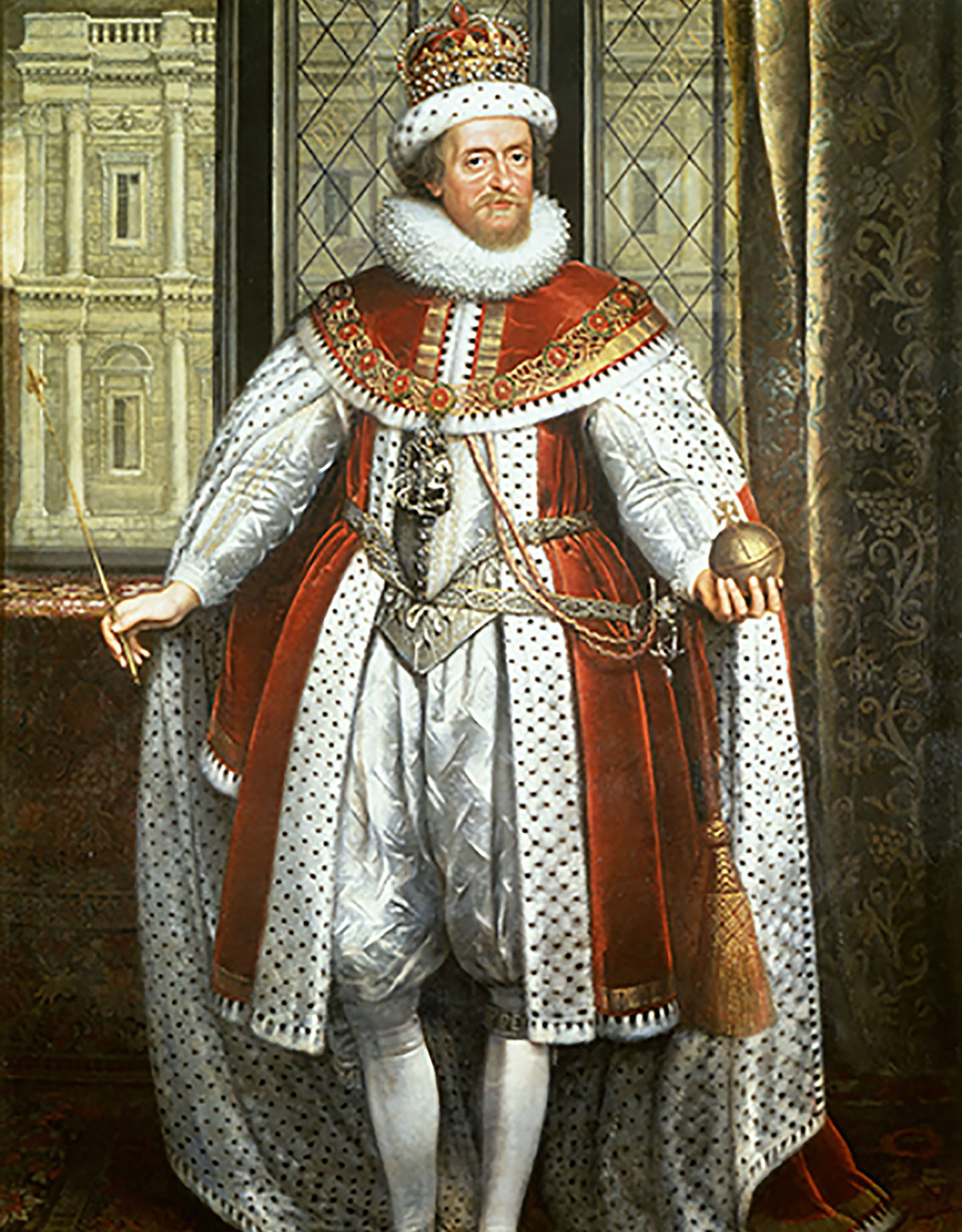
James I (1566-1625)
King of Scotland beginning in 1627, and of England beginning in 1603 following the death of Queen Elizabeth I, the last of the Tudor dynasty. James was brought up as a Presbyterian in Scotland and had an ongoing interest in theology and in the state of the Reformed church across Europe. Huguenot leaders from France petitioned the king to put his authority behind their scheme to bring together Reformed church leaders from across Europe to build the cause of Reformed unity. The States-General that issued the invitations to the Synod of Dordt sent their letter of invitation directly to James in the summer of 1618. The king selected the four English and one Scottish delegate who attended the Synod, and personally met with the English delegates before they set off for Dordrecht. The delegates and the English ambassador to the Dutch Republic, Dudley Carleton, kept the king abreast of developments, so that even though he was not in attendance, the king played a determining role both in the set-up and the progress of the gathering.
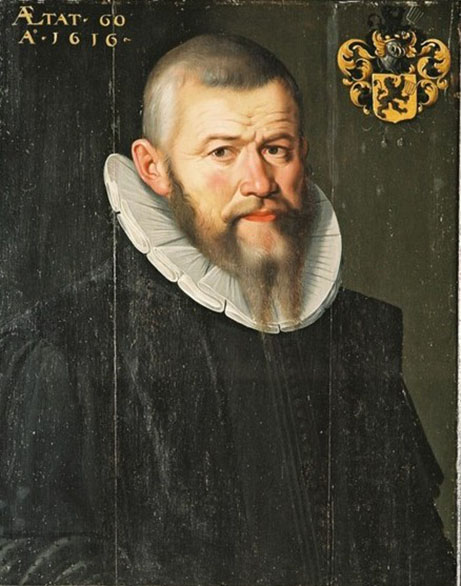
Lubbertus, Sibrandus (1555-1625)
Born in lower Saxony, he studied at Wittenberg, Geneva, Neustadt, Marburg, and Heidelberg, obtaining his doctorate in theology from Heidelberg in 1587. He began teaching theology at the University of Franeker in 1585, and remained there as professor of theology for forty years. He was a hard-line orthodox Calvinist, writing long polemical works against his theological opponents, including the jurist Hugo Grotius and Leiden theology professor Conrad Vorstius. Lubbertus served as one of the academic delegates at the Synod of Dordt.
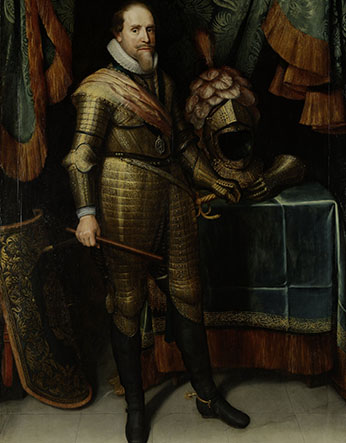
Nassau, Maurice of (1567-1625)
The son of William of Orange, who led the Dutch push for independence from Spain, Maurice succeeded his father as stadtholder (the highest executive official) in five of the seven Dutch provinces by 1590. Maurice proved to be a highly-effective military commander, continuing the Dutch pressure against the Spanish and becoming famous as a military strategist. His earlier support for Johan van Oldenbarnevelt slipped as they disagreed over the twelve-year truce Oldenbarnevelt negotiated with Spain. Maurice allied himself with the Counter-Remonstrants and engineered Oldenbarnevelt’s downfall in 1618.
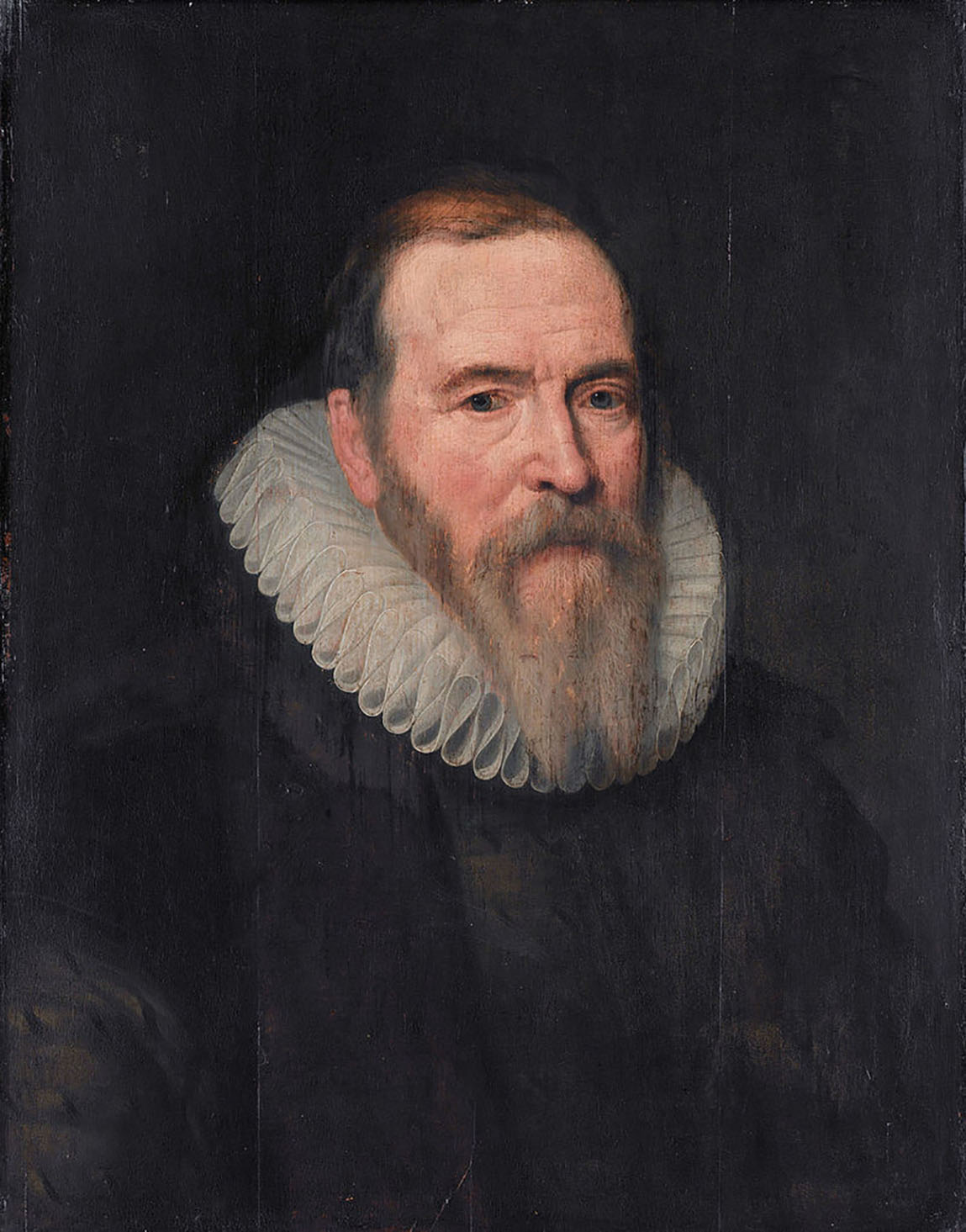
van Oldenbarnevelt, Johan (1547-1619)
Born in Amersfoort in the province of Utrecht, he went to Louvain, Bourges, Heidelberg, and Padua to study law. He entered government service first as a legal advisor to the city of Rotterdam, and then as land’s advocate for the States of Holland, holding a role similar to that of a prime minister today. Although early on in his career he had the strong support of Maurice of Nassau, the two men increasingly diverged as tensions increased in the Dutch provinces over the divide between Remonstrants and Counter-Remonstrants, but also due to social and economic issues. When Oldenbarnevelt and the States of Holland took actions to strengthen Holland’s provincial authority over against church bodies or any other court, the other states and Maurice took these measures as a sign that Holland wanted to gain control at the expense of the other provinces. Oldenbarnevelt was arrested in August 1618, and charged with treason. After a show trial, he was condemned and executed in May 1619, shortly before the end of the Synod of Dordt.

Vorstius, Conrad (1569-1622)
Born in Cologne in a Roman Catholic family, Vorstius converted to the Reformed faith and studied in Herborn, Heidelberg, Basel, and Geneva. He taught theology in the academy at Steinfurt near Münster from 1596 to 1611, when he became the successor to Jacob Arminius as professor of theology at the University of Leiden. His appointment became a flash point for controversy due to persistent accusations from orthodox Calvinists including Sibrandus Lubbertus, Franciscus Gomarus and even James I of England that Vorstius held heterodox views on fundamental Christian doctrines. His detractors accused him of Socinianism (an anti-Trinitarian stance). Vorstius’ unorthodox theology made it difficult for his Arminian supporters to defend his views, so Hugo Grotius and others concentrated instead on defending the government’s fundamental right to appoint professors to university chairs without interference from the church. As a result of the controversy, Vorstius was dismissed from his post in 1612, and in 1619 was banished from the Dutch Republic. At the time of his death in 1622 he was living in exile in the German territory of Holstein.

Wtenbogaert, Johannes (1557-1644)
Born in Utrecht into a Roman Catholic family, he broke with Catholicism in 1578 and went to Geneva to study theology beginning in 1580. He served as a Reformed pastor in Utrecht and in The Hague, and as court preacher and military chaplain to Maurice of Nassau. He became the leader of the Remonstrants following the death of Arminius. In 1618, following the arrests of Oldenbarnevelt and Grotius, Wtenbogaert fled to Antwerp in the Spanish Netherlands. In 1619, the States General banished him from Dutch territory. He went into exile to France, though he returned in 1626, following the death of Maurice of Nassau. From then on until his death in 1644, Wtenbogaert served as a Remonstrant pastor in The Hague.

Arminius, Jacobus (1560-1609)
Born in Oudewater (province of Utrecht), he studied at the University of Leiden, at the University of Basel, and at the Genevan Academy. He became a pastor in Amsterdam in 1587 and joined the faculty of theology at the University of Leiden as professor in 1603. Both as a pastor and a professor, Arminius increasingly made public his critique of hardline Calvinist predestinarian theology. In oral debates and in print, his opponents accused him of reviving the ancient Pelagian heresy that taught that human beings had free will and could cooperate with God in working towards their salvation. Arminius rejected these charges and condemned Pelagian views. His main opponent at the University of Leiden was his colleague Franciscus Gomarus. The two men clashed repeatedly in person and in writing up to Arminius’ death in 1609. His followers and supporters later became known as Arminians (not to be confused with Armenians, who are people from Armenia in western Asia)

Bogerman, Johannes (1576-1637)
Born near Emden in northern Germany, Bogerman studied in Heidelberg, Geneva, and Zurich, with shorter stays in Lausanne, Oxford, and Cambridge. He became a pastor and served congregations in Sneek, Enkhuizen, and Leeuwarden. He chaired three provincial church synods in 1605, 1610, and 1615. His expertise in church government and his orthodox Calvinist perspective led him to be asked to preside at the Synod of Dordt. He contributed to the translation of the Old Testament into Dutch for the Statenbijbel. In 1636, he became professor of theology at the University of Franeker. He died there in the following year.
Timeline
Browse a timeline of events from the beginning of the Reformation to the publication of the Statenvertaling Bible.
The events of the Synod of Dordt in 1618-19 only make sense within the larger context of the Reformation. Here are some of the most important dates that shaped the course of the Reformation right up to the time of the synod.
- 1516 Erasmus publishes Greek New Testament
- 1517 Luther publishes his 95 theses on indulgences
- 1520 Charles V becomes ruler of the Netherlands
- 1522 The Inquisition is set up in the Netherlands
- 1527 beginnings of Anabaptism in the Netherlands
- 1534 Henry VIII declares himself head of the church in England
- 1536 Calvin arrives in Geneva
- ~1544 the first Reformed churches emerge in the Netherlands
- 1561 Guy de Bres writes the Belgic Confession
- 1563 the Heidelberg Catechism appears in print
- 1566 Wonderyear: Dutch Calvinists hold open-air preaching and destroy religious images
- 1567 Duke of Alva sent by Spain to root out heretics and those responsible for iconoclasm
- 1567 Guy de Bres is martyred in the southern Netherlands
- 1571 first Synod of the Dutch Reformed Church meets in Emden, outside the Netherlands
- 1572 outbreak of the Dutch revolt against Spain
- 1573 Philip II recalls the Duke of Alba after 5,000 executions
- 1573 Dutch revolt leader William of Orange moves from Lutheranism to the Reformed faith
- 1579 formation of the Union of Utrecht - seven northern Dutch provinces band together
- 1587 around one tenth of the Dutch population belongs to the Reformed church
- 1591 Jacobus Arminius begins preaching on Romans 7
- 1605 Calls for revision of the confessions and catechism of the Dutch Reformed Church
- 1607 Oldenbarnevelt thinks he has the momentum to call a synod to revise the Belgic Confession
- 1607 Utrecht guildsmen form militia to purge the town council of regents with Arminian leanings
- 1609 Start of twelve-year truce between Spain and the Dutch Republic
- 1609 Jacobus Arminius dies
- 1610 Remonstrant Conrad Vorstius succeeds Arminius as theology professor at Leiden
- 1610 Arminians ask for freedom to preach, issue Remonstrance to the States of Holland"
- 1612 Simon Episcopius becomes theology professor in Leiden
- 1617 Oldenbarnevelt leads Holland and West Friesland to issue The Sharp Resolution arguing they can levy their own armies as sovereign provinces and requiring officials, magistrates, and soldiers to sign an oath of obedience to the states of Holland
- 1618 Coup led by Prince Maurice of Nassau purges Arminians from town councils
- August 29, 1618 detention of Oldenbarnevelt and dismissal of his soldiers by Maurice of Nassau
- November 13, 1618 Synod of Dordt opens
- January 14, 1619 Arminian faction dismissed from the Synod of Dordt
- April 23 adoption of the Canons of Dordt
- May 13, 1619 Oldenbarnevelt beheaded
- May 29 Synod of Dordt closes
- 1619 around two hundred Remonstrant pastors deposed
- 1621 war with Spain begins again
- 1626 Simon Episcopius returns to the Netherlands to be the pastor of a Remonstrant church in Rotterdam and later rector of the Remonstrant college in Amsterdam
- 1637 Statenvertaling publication
The Statenvertaling Bible
Read about the publication of the first full translation of the Bible into Dutch from its ancient sources.
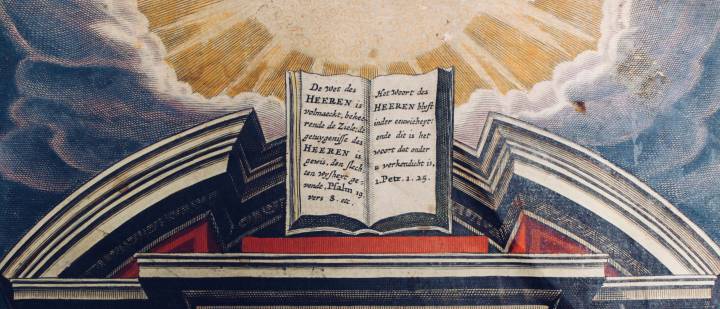
In the first sessions of the Synod of Dordt in November 1618, before the delegates of the Synod even addressed the divisive Arminian controversy, they joined together to commission a new Bible. Published nineteen years later in 1637 after a laborious translation process, the Statenvertaling (States' Translation) was the realization of the initial work of the Synod of Dordt.
But the wait for a complete Dutch Bible that drew from the original languages of Scripture had been much longer than the nineteen years between Dordt and 1637. Since the Reformation, and even the Middle Ages, the residents of the Low Countries had read the Bible, but inquisition and persecution, a revolt from Spain and controversy with the Remonstrant (Arminian) faction in the national church, delayed the translation and publication of a complete Dutch Bible translated from the ancient languages.
Medieval Bible Reading in the Low Countries
1548 Louvain Bible open to an illustration of Creation. The Louvain Bible was translated by the Augustinian monk Nicolaas van Winghe who worked from the Latin Vulgate text.
The Statenvertaling is considered one of the best translations of the Reformation era and remained the preeminent Dutch Bible well into the twentieth century. New Dutch Bibles (published in 2004 and 2010) have recently replaced the Statenvertaling as the primary Dutch Bibles in use. Even these translations, written centuries later, use the seventeenth century Statenvertaling as their starting point—attesting to the lasting quality and continuing influence of the work of the Synod of Dordt and the translators.
Before the Statenvertaling and the Reformation, the Low Countries had a tradition of lay readership in the Middle Ages. The Devotio Moderna movement of popular religious enthusiasm in the fourteenth century argued that reading the Gospels was necessary for learning to live like Jesus Christ and the Apostles. Beguines, Beghards, and other pious lay groups inspired by the movement often had parts of the Bible translated into vernacular. Rather than lay readership being scandalous to the institutional church, in the Middle Ages it was sometimes encouraged by clergy within the church. Monks both translated and copied works as an act of spiritual meditation or for a rich patron. Some clergy even recommended that their parishioners read the Bible on their own time.
Protestant Bibles and the Challenge of the Reformation
The Dutch Christian Humanist Erasmus of Rotterdam pictured in the Icones from 1580, a who’s who of the Reformation written by Beza, John Calvin’s protégé.
The Roman Catholic Church did have an official Bible translation—the Latin Vulgate, first translated by the Church father Jerome in 405 CE—which it upheld as the exclusive Latin authority for the Bible. In the fifteenth and sixteenth century, with the rise of interest in texts from antiquity, scholars called humanists began translating the text of the Bible from the original Hebrew and Greek. A Dutchman, the famous Erasmus of Rotterdam, was deeply influential in this movement, notably for his translation of the New Testament from Greek into Latin. While vernacular Bibles and other aids to piety for lay people—like block prints of biblical stories, parts of the gospels, and books of hours—had been circulating for centuries, the Reformation Bible provided a new challenge. It was scrupulous, trying to cling tight to the original languages and meaning—which Luther argued was the only infallible guide for religious belief and practice—and even pointing out grammatical and linguistic errors in Jerome’s translation.
As the Reformation progressed and Protestant groups split, more Bible translations appeared. Luther and his colleagues in Wittenberg produced a complete Bible in German in 1534. By 1611 the national church in England had the King James Bible. Sometimes the Bibles were commissioned and written to be the first complete vernacular Bible from the original languages and other times to counteract the influence of the biblical translations of other groups. For instance, the King James Bible was meant to counteract the popularity of the Geneva Bible (influenced by Calvin) in England.
Conflict and Commissioning
Following the Reformation, the Dutch provinces were an unstable place for Protestant belief and therefore, Protestant Bible translation. The Dutch Inquisition, established by Charles V of Spain in 1521, published an index of prohibited books. Although the index was inconsistently enforced, Jacob van Liesveldt, who wrote a complete Dutch Bible translation working from Luther’s text, was put to death in 1545 on the charge of heresy. Perhaps because of this context, Dutch translations were mostly fragmentary or secondary translations, working from the Latin Vulgate, the German Luther Bible, and even Erasmus’ New Testament.
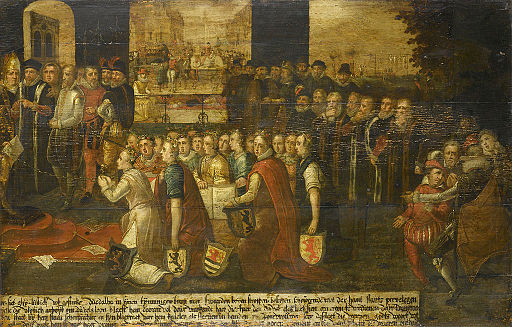 Allegory of the Tyranny of the Duke of Alva in the Netherlands by an anonymous painter (Rijksmuseum Amsterdam). Surrounding the pleading Dutch citizens are images of persecution and death.
Allegory of the Tyranny of the Duke of Alva in the Netherlands by an anonymous painter (Rijksmuseum Amsterdam). Surrounding the pleading Dutch citizens are images of persecution and death.
The Reformed churches of the Netherlands began to form around 1544, but because of the persecution experienced by Protestants and war with Spain, the churches met in exile at the 1571 Synod of Emden. The standard Bible translation within the Reformed community at that time was the Deux Aes Bible that combined a number of secondary translations. At the Synod, a group of refugees from Cologne explicitly stated the need for a new Dutch translation, an appeal that was later repeated at the 1586 synod in The Hague. The trying political situation in the Netherlands prevented further synods from meeting and hampered the translation of a new Bible. Finally, after the declaration of the Twelve Years Truce between the Netherlands and Spain and a coup by Maurice of Nassau that turned the political tide towards the Counter-Remonstrants (Orthodox Calvinists) within the Reformed Church, the States General called a national synod together. The Synod of Dordt met between November 1618 and May 1619. The first issue on the agenda at the Synod was the translation of a new Bible. Johannes Bogerman, the president of the Synod and an expert in biblical languages, brought up the King James Bible as well as Spanish and Italian translations that worked from the original languages, pointing out the framework the Dutch Bible should follow. The delegates unanimously voted to commission the new Bible.
While the commissioning was unanimous, the delegates debated what to do with the apocrypha. Lay people read the apocrypha for centuries before the Reformation, and many Reformed churches accepted the apocryphal texts. But Franciscus Gomarus (the late Arminius’ opponent on the faculty at Leiden), and Jean Diodati, (Beza’s student and an Italian biblical translator), were against it. The apocrypha, they argued, conflicted with scriptures and was dogmatically wrong. After debate, the Synod of Dordt decided that the translators should place the apocrypha at the back of the Bible with a preface warning the reader.
The Translation Process
The Synod of Dordt stipulated that the translators should be both scholarly and pious. To balance out the Dutch vernacular dialects, the translators were ministers from different provinces. The revisors included a number of theologians as well as parish ministers. Although the Netherlands was a center of biblical scholarship and philology at the time, the pastor Henricus Alting doubted he could translate the Old Testament Hebrew. Johannes Bogerman told him, “an average knowledge will suffice...the solid explanation of a biblical place is far more important than the conjectures of a thousand critics.”[1]
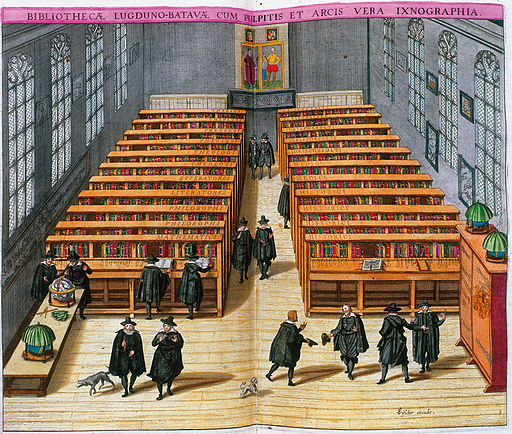 Universiteitsbibliotheek Leiden drawn by Johannes Woudanus in 1610.
Universiteitsbibliotheek Leiden drawn by Johannes Woudanus in 1610.
The translators of the Statenvertaling oscillated between two poles of biblical interpretation: the belief that scriptural meaning was self-evident and the fear, fresh from the recent Arminian debate, that scripture could be read in vastly different ways. Their responsibility thus became to translate and gloss the texts to encourage right belief, but not treat the Bible as cryptic and, therefore a threat to right belief. The Synod of Dordt helped by providing a guide for the translators: if the original languages could not be meaningfully translated, the translators were to note this in the margin; each book of the Bible would contain a clear summary of the contents; and finally, the translators could add explanations in the margins to justify their translation but should not diverge into elaborate doctrinal discussions.
1660 Statenvertaling based on the 1657 revision of the translation.
The translation process, like the Synod, was a process of consensus with committees, voting, and months of labor. The meetings began in 1626 in Johannes Bogerman’s house in Leiden and continued on despite the death of multiple translators and the 1635 plague. The translators (six of them, three for each Testament) worked on a section of translation at home, before meeting with each other to discuss their work. Every sentence was agreed upon with absolute consensus and then moderated by a group of twenty revisers. Caspar Sibelius, a New Testament translator, later recounted how the laborious process affected Festus Hommius, a fellow translator. “He had grown old,” Sibelius wrote of his friend, “burdened, and tired, and [the] sustained labor had broken his strength.”[2] Finally, after a delay in funding, the Statenvertaling was published in 1637. In their introduction, the States General declared the Bible, “fitting, conformably to the example of the primitive Church, in the time of the Fathers, and likewise to that of our Neighbor and other Reformed Kingdomes”—the finished Bible reached back to ancient times and the early church, yet it spoke to the current age and Reformed republic.
The Continued Effect of the Statenvertaling
Within Calvin University’s rare book collection, there are over seventy-five Statenvertaling Bibles. Some of the Bibles have handwritten family trees, tracing lineages from the mid-seventeenth century to the late-twentieth. Many of them were donated by families in West Michigan, who at some point transported the Bibles from the Netherlands to the United States. Some of the Bibles are small enough to fit within a handbag. Others are huge and heavy, with thick wooden covers and brass clasps. Some Bible have large maps that fold out, depicting Jerusalem, the world, or the Holy Land, and diagrams of the construction of the ark of the covenant, while others have only the standard illustrated lettering at the start of every book of the Bible and the filigreed “finis” at the end. The variety of Statenvertaling Bibles sampled at the Calvin University Hekman Library attests to the translation’s popularity and versatility. After its initial 1637 publication by Paulus Aertsz van Ravesteyn in Leiden, the Statenvertaling was reprinted twenty-two times before the turn of the eighteenth century. For the next two centuries, the Statenbijbel was the most-owned book in the Netherlands.
1737 Statenvertaling New Testament open to the Psalms set to music.
Beyond communicating the message of the Bible, the Statenvertaling played a wider role in the confessionalization of Dutch society. Many Statenvertaling Bibles contained psalters in the back to guide believers in worship and personal piety. So-called Frauen Bijbels were given as gifts to women upon marriage, showing the social significance of the Bible. The language itself of the Statenvertaling, formed carefully by the translators from across all the provinces, helped create the standard Dutch language still used today. The Philadelphia Statenvertaling in Calvin University’s collection contains an entire catechism and multiple Reformed confessions that continued the work of promoting Dutch Reformed piety even beyond the Netherlands and well into the nineteenth century.
The historian Jonathan Israel, in his seminal work on the Dutch Republic, calls the Netherlands during the time of revolt an “ecclesiastical vacuum” in which most people held no confessional affiliation and Christianity did not shape their daily lives.[3] Decades later, the story of the Statenvertaling is quite different: it shows a Dutch Republic galvanized by the Arminian controversy, eager to fund and promote orthodoxy, and a people willing to adopt the Statenvertaling—a product of the Reformed Church and the States General—into an intimate and personal part of their lives for centuries.
Find links to upcoming conferences and exhibits and resources for further reading about the Synod of Dordt.
Find out more about the Synod of Dordt through conferences, exhibits, and websites commemorating the 400th anniversary.
Conferences
- September 14-15: Synod of Dordt Conference at Calvin Theological Seminary
- November 11, 2018-June 2, 2019: Printing on Demand: 400 years Dordt and the States Bible — in Het Hof van Nederland, Dordrecht
- November 14-16: “The International Synod of Dort: Contents, Contexts, and Effects” Conference in Dordrecht, the Netherlands
- April 4-6, 2019: “The Prodigal Love of God: Reencountering Dort at 400 and Beyond” Conference at Dordt College, Iowa
- May 8-9, 2019: The Theology of Dort (1618–1619): Confessional Consolidation, Conflictual Contexts, and Continuing Consequences in Groningen, The Netherlands
Exhibits and Museums
- November 10, 2018 – May 2019: “Work, Pray, Admire: New Views on Calvinism and Art” at the Dordrecht Museum, the Netherlands
- November 11, 2018-June 2, 2019: Bios [Bible] in Dordrecht robot that writes Statenvertaling manuscript
- Find out more about the Statenvertaling at the Dutch museum dedicated to the Statenbijbel
- November 24, 2018-May 26, 2019: Ode aan de Synode — renowned Groningen painter Henk Helmantel in the Grote Kerk in Dordrecht
Around the Web
- Christian Courier blog post by Donald Sinnema, one of the leading North American experts on the Synod of Dordt, highlighting the work of the synod and introducing the project to publish the acts of the synod in their original language
- Tabletalk Magazine Blog post by W. Robert Godfrey on the Synod of Dordt, its context, and its theological significance
For young readers
- William Boekestein. The Glory of Grace: the Story of the Canons of Dordt (Grand Rapids: Reformation Heritage Books, 2012). illustrated 32-page book introducing young readers to the history of the Dutch Reformation, the theological debates, and the outcomes of the Synod
Scholarly resources
- Aza Goudriaan and Fred van Lieburg, eds. Revisiting the Synod of Dordt (1618-19) (Leiden: Brill, 2011) includes sixteen contributions on various aspects of the synod, from theological issues to reports and correspondence from synod delegates
- Anthony Milton. The British delegation and the Synod of Dort (1618-1619) (Woodbridge: Boydell Press, 2005) The definitive study on England’s connections with the Synod of Dordt, both before and after the international gathering took place
- Donald Sinnema, Christian Moser, and Herman J. Selderhuis. Acta et Documenta Synodi Nationalis Dordrechtanae (1618-1619) (Göttingen: Vanderhoek & Ruprecht, 2015) First volume of a planned series publishing an annotated edition of the acts of the Synod of Dordt in the original Latin text. Includes a very helpful introductory section providing background on the synod and its delegates
About the conference: Just over four hundred years ago, in 1620, the Mayflower arrived on the shores of Cape Cod. Many of those on board had left England first for the Netherlands and then embarked on the transatlantic voyage because they felt they could not live within the theological and liturgical framework of the established Church of England. Within the next decades, these dissenters, known as the Pilgrims, were joined by other Puritans, establishing colonies along the northeastern seaboard of North America.
Many aspects of this migration have become part of the fabric of the story of the United States, yet this legacy is complex and deserving of further reflection. To shed light on the Puritans and their impact, and to foster informed discussion, the Meeter Center is organizing a two-day conference on September 24 and 25, 2021, at the Meeter Center Lecture Hall on the Calvin University campus. All are heartily welcome. In plenary lectures and panel discussions, expert presenters will focus on the theological roots of Puritanism and on the history of Puritans' actions and legacies in North America, including their relations with Native American communities.
Speakers include Margaret Bendroth (executive director (ret.) of the Congregational Library and Archives), Richard Muller (emeritus, Calvin Theological Seminary), Matthew Tuininga (Calvin Theological Seminary), Chad Van Dixhoorn (Westminster Theological Seminary Philadelphia), Abram Van Engen (Washington University in Saint Louis), and Adrian Weimer (Providence College). Additionally, the Meeter Center currently houses a Puritan exhibit, with several rare books on loan from Puritan Reformed Seminary's extensive collection. Don't miss this outstanding opportunity!
To watch the recordings of these conference sessions, check out our YouTube playlist.
Swiss Reformation Conference
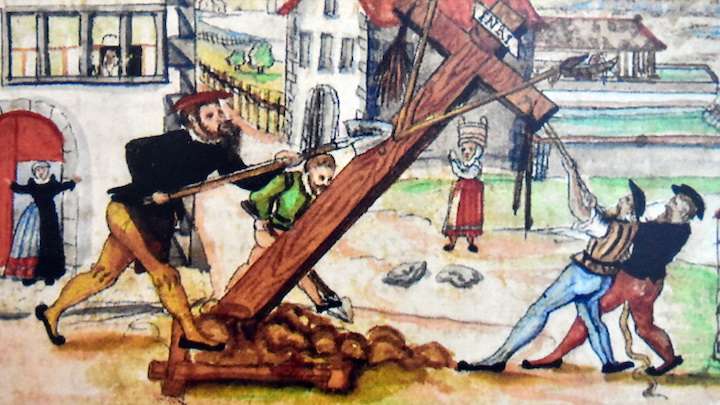
Swiss Reformation Conference
- To mark the 500th anniversary of the Swiss Reformation, and to highlight its enduring impact, the Meeter Center hosted a conference that featured an exhibit of early printed books related to the Swiss Reformation and a re-enactment of the January 1523 disputation.
Think “Reformation”, and the words Martin Luther, Wittenberg, 95 Theses, and 1517 spring to mind. But Luther was not the only Reformer, and Wittenberg was not the only city where the Reformation began. About 360 miles further south, in the Swiss city of Zurich, Huldrych Zwingli began his public ministry in January 1519, preaching sequentially through the Gospel of Matthew. Like Luther, Zwingli started out his career as a Catholic priest. Like Luther, Zwingli had studied the Bible extensively, in Zwingli’s case focusing on Erasmus’s Greek New Testament.
As he worked and preached in Zurich, Zwingli increasingly noticed the divergences between what the Bible said and the practices of the Catholic church of his day. Why did the Church say people had to abstain from meat during Lent? Where in the Bible did it say that clergy had to be celibate? Zwingli’s questions grew as did discussions in the city about the need for a Reformation in church practice and doctrine. By 1523, the Zurich magistrates authorized two major public debates between Zwingli and his colleagues and supporters on the one side, and defenders of traditional Catholicism on the other. The official process of Reformation had begun. By 1523, preachers in Zurich were to base themselves solely on Scripture for their sermons. By 1525, the Catholic Mass had been banned in Zurich’s territory.
To mark the 500th anniversary of the Swiss Reformation, and to highlight its enduring impact, the Meeter Center is hosting a two-day conference on Friday Sept. 13 and Saturday Sept. 14, 2019, at Calvin Theological Seminary. Speakers include Bruce Gordon (Yale), Amy Nelson Burnett (Nebraska-Lincoln), John Roth (Goshen), Jordan Ballor (Acton), and Esther Chung-Kim (Claremont-McKenna). The conference will also feature an exhibit of early printed books related to the Swiss Reformation and a re-enactment of the January 1523 disputation. Don’t miss it!
Bruce Gordon: “Remembering Zwingli in 2019: Current Debates about the Reformer and His Legacy”
Bruce Gordon is the Titus Street Professor of Ecclesiastical History at Yale Divinity School. He obtained his Ph. D. from the University of Saint Andrews, in Scotland, where he taught modern history and served as deputy director of the Saint Andrews Reformation Studies Institute before joining the faculty at Yale. He is the author of several major works, including The Swiss Reformation (Manchester University Press, 2002) and Calvin (Yale University Press, 2009).
Amy Nelson Burnett: “Clash of the Titans: Luther, Erasmus and the Sacraments in the Swiss Reformation”
Amy Nelson Burnett holds the Paula and D.B. Varner University Professor of History chair at the University of Nebraska-Lincoln, where she specializes in early modern European history. She received her Ph. D. from the University of Madison-Wisconsin. She is the author of Teaching the Reformation: Ministers and their message in Basel, 1529-1629 (Oxford University Press, 2006), and co-editor of A Companion to the Swiss Reformation (Brill, 2016). Her latest book is Debating the Sacraments: Print and Authority in the Early Reformation (Oxford University Press 2019).
John Roth: “'The axe has been laid to the root...': Zwingli, the Anabaptists, and the Limits of Reform in the Swiss Reformation”
John Roth is a professor of history at Goshen College, and Director of the Institute for the Study of Global Anabaptism (ISGA). He is the author of several works including Stories: How Mennonites came to be (Herald Press, 2006). He is currently at work on Separationism and the Believers Church Tradition, ed. William Brackney and John D. Roth (Eugene, Ore.: Wipf and Stock, forthcoming). He received his Ph. D. from the University of Chicago. He was a recipient of the Washington Theological Consortium 2018 Ecumenism Award “for outstanding contributions to the Mennonite-Lutheran dialogue, scholarship, and leadership in the wider cause of Christian unity.”
Jordan Ballor: “Church, State and the Swiss Reformation”
Jordan Ballor earned his doctorate in theology from the University of Zürich, and his Ph. D. from Calvin Theological Seminary. He is currently a senior research fellow and the director of publishing at the Acton Institute for the Study of Religion and Liberty. He conducts postdoctoral research in theology and economics at the Vrije Universiteit Amsterdam as part of the “What Good Markets are Good for” project. He is the author of Covenant, Causality, and Law: a study in the theology of Wolfgang Musculus (Vandenhoek and Ruprecht, 2012).
Esther Chung-Kim: “Poor Relief and the Politics of Preaching in Sixteenth-Century Zürich”
Esther Chung-Kim is an associate professor of religious studies at Claremont McKenna College. She specializes in the history of world Christianity, including the European Reformation, and also teaches seminars on Poverty, Wealth and Social Change, European Reformations, and Christianity and Politics in East Asia. Her most recent journal article is titled, "Aid for Refugees: Religion, Migration and Poor Relief in Sixteenth-century Geneva," in Reformation and Renaissance Review 20:1 (2018). She obtained her MDiv from Princeton Theological Seminary and her Ph. D. from Duke University.
Bruce Gordon: “Remembering Zwingli in 2019: Current Debates about the Reformer and His Legacy”
It is something of a truism in Reformation scholarship to refer to Huldrych Zwingli as the "forgotten" reformer or as the "third man" after Martin Luther and John Calvin. There are many reasons why Zwingli's reputation has suffered, beginning in the sixteenth century when his successor Heinrich Bullinger struggled to defend the reputation of a prophet who died in battle. John Calvin believed that Zwingli was so controversial that he almost never mentioned his name, claiming, against the truth, never to have read the Swiss churchman. The 2019 anniversary of Zwingli's arrival in Zürich has led to significant and heated discussion of his thought and deeds, as well as of his legacy for the Reformed tradition in general and for his native Switzerland in particular. The most expensive movie ever produced in Switzerland is the recent biopic of Zwingli, and it has been a commercial success in a very secular country. Why? This talk will examine recent debates surrounding the contested role of this brilliant yet flawed reformer that have appeared in scholarship, newspapers and visual media, and public exhibitions.
Amy Nelson Burnett: “Clash of the Titans: Luther, Erasmus, and the Sacraments in the Swiss Reformation”
The Eucharistic controversy is often presented as a conflict between two theological giants, Martin Luther and Huldrych Zwingli, concerning Christ’s “real presence” in the sacrament. The early debate over the Lord’s Supper was more complicated than this, however. It went beyond the issue of Christ’s presence to include the nature of the sacraments more generally, questions concerning biblical interpretation, and the relationship between spiritual and material reality. Luther’s real opponent concerning the sacraments was Erasmus of Rotterdam, and Zwingli was only one of several thinkers who contributed to what would become the Reformed understanding of the sacraments. A description of the debate between Luther and his Swiss opponents over the Lord’s Supper helps us better understand the development of the Reformed tradition in conflict with both Lutheran and “baptistic” understandings.
John Roth: “’The axe has been laid to the root . . .’: Zwingli, the Anabaptists, and the Limits of Reform in the Swiss Reformation”
In 1523 Zwingli proclaimed, “Where there is faith, there is freedom.” Within only a few years, however, the freedom that he claimed from the Catholic Church was one that he was no longer willing to extend to alternative perspectives. The division within the early Swiss Reformation that led to the emergence Anabaptist movement started out as a “family quarrel.” But by 1525, the Zürich City Council declared adult baptism to be a capital offense, and executions of Anabaptists continued in Zürich and the surrounding countryside until 1614. This presentation will explore the beginnings of the Anabaptist movement in Zürich and the challenge that movement poised to Swiss Reformation as it took shape under Zwingli and Bullinger.
Jordan Ballor: “Church, State and the Swiss Reformation”
This presentation takes its point of departure in the contrast often drawn between the models of church and state represented by Zürich and Geneva, the ‘Erastian’ and the ‘Calvinist’ perspectives, respectively. While this contrast provides some helpful insights, the relationship between church and state in Reformation-era Switzerland is more complex and nuanced. When elements including excommunication, conscience, and toleration are added to our understanding, a more diverse and variegated landscape comes to the fore, with important implications for the development of liberalism and religious freedom down to the present day.
Esther Chung-Kim: “Poor Relief and the Politics of Preaching in Sixteenth-Century Zürich”
This presentation reveals that while early Swiss reformers accepted the demarcations of political and religious spheres, the one arena in which second-generation reformers challenged the model of separate spheres of political and religious jurisdictions was poor relief. This contention arose because of two reasons. First, Swiss reformers considered poor relief a religious issue and embodied their role as prophet in their advocacy for the needy. Second, reformers such as Heinrich Bullinger who served as chief minister of Zürich after Zwingli’s death expected the communal wealth of church property that had been confiscated by the city magistrates to be used for poor relief. Swiss reformers, such as Heinrich Bullinger believed that the magistrates needed the ministers to guide them in the right use of communal wealth. In his interpretation of Scripture, Bullinger expressed his religious ideals for the sharing and distribution of wealth, since gifts and donations “given to God” were meant for godly purposes. In his speeches before the city council, he criticized the civil magistrates for misuse and misappropriation of church funds that were reserved for the poor. Since poor relief was an expression of religious ideals manifested in a community, Bullinger engaged in the politics of preaching to encourage, even demand the proper use of communal wealth.
Synod of Dordt Conference
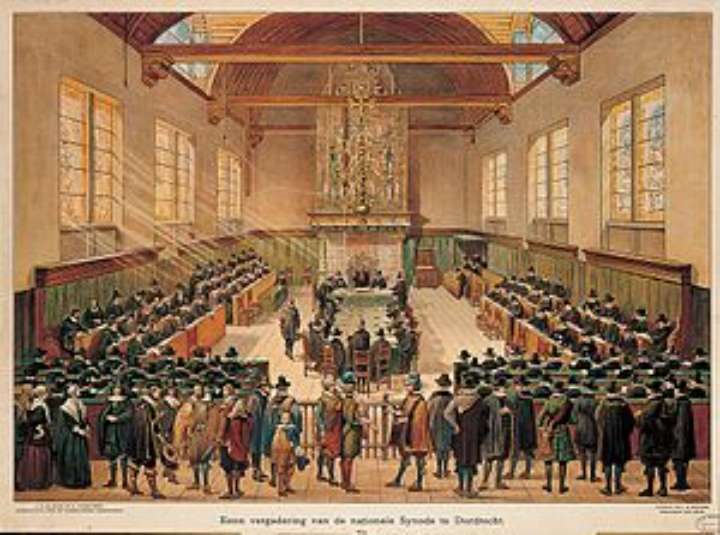
Synod of Dordt Conference
- This conference was held to commemorate the Synod of Dordt and its work brought together a range of experts to explain in accessible presentations what the Synod did.
Although the Synod of Dordt is most well-known today for affirming double predestination, rejecting the teachings of Jacob Arminius, and producing the Canons of Dordt, its work encompassed a broad range of issues, including church order, catechisms, Bible translation, theological training, and more. This two-day conference to commemorate the Synod of Dordt and its work brought together a range of experts to explain in accessible presentations what the Synod did, why this gathering was significant at the time, and how this four-hundredth anniversary should be commemorated in churches and communities today. Presentations are geared to the general public and include visuals, music, panel discussions, and a special exhibit of Statenbijbels, the official Dutch Bible commissioned by the Synod and first published in 1637.
Co-sponsored by the H. Henry Meeter Center for Calvin Studies, Calvin Theological Seminary, Western Theological Seminary, the Christian Reformed Church in North America, and the Calvin University Seminars in Christian Scholarship.
Conference Lectures
Don Sinnema: “A Virtual Tour of the Synod of Dordt (1618-1619)”
Don Sinnema is a Dordt College graduate, who did his doctoral dissertation on the Synod of Dordt at the University of Toronto (St. Michael’s College). He taught for 25 years as a professor of theology at Trinity Christian College. His fields of academic interest are Post-Reformation studies and Dutch-American (and Dutch-Canadian) studies. Since retiring from Trinity in 2012, he has moved to Holland, Michigan. He is one of three general editors of the 10 volume Acta et Documenta Synodi Nationalis Dordrechtanae (2015- ).
Keith Stanglin: “The Remonstrant perspective”
Keith Stanglin is Professor of Historical Theology at Austin Graduate School of Theology in Austin, Texas, where he is the editor of the journal Christian Studies and of the faculty blog. He is also the coordinator of the master’s degree program. He has written many books and articles, including Jacob Arminius: Theologian of Grace(Oxford University Press, 2012) and The Reformation to the Modern Church: A Reader in Christian Theology (Fortress Press, 2014). His most recent book is The Letter and Spirit of Biblical Interpretation: From Early Church to Modern Practice (Baker Academic, 2018).
Dr. Suzanne McDonald: “The Canons of Dort for the Church Today: Polemics, Pastoring, and Pulling up TULIPs”
Rev. Dr. Suzanne McDonald is Professor of Systematic and Historical Theology at Western Theological Seminary in Holland, MI. Before that she taught for seven years in the Religion Department at Calvin University. She is ordained in the CRC, and has written books and essays on a range of subjects, including the doctrine of election, John Knox, and the theology of John Owen.
Dr. Randall D. Engle, PhD: “Song of the Synod”
Dr. Engle is Professor of Religious Studies at Oakland University (Rochester Hills, Michigan) and minister of the North Hills Christian Reformed Church of Troy, Michigan. His undergraduate degree in music (organ performance) is from Calvin University; his M.Div from Calvin Seminary; his M.Th from St. Paul Seminary, St. Paul, Minnesota; and his PhD from the University of Wales. He resides in Troy, Michigan, with his wife Kathy and miniature dachshund Milly.
Fred van Lieburg: “The public gallery of the Dordt Synod”
Fred van Lieburg is professor of religious history in the Faculty of Humanities at Vrije Universiteit Amsterdam. He specializes in Dutch Reformed Protestantism and in international Pietism and Revivalism traditions. His publications include a volume on the Synod of Dordt (1618-1619), edited with Aza Goudriaan (Leiden: Brill, 2011) and he is now completing a book on the synod from a political and local perspective (Amsterdam: Prometheus, 2018).
Don Sinnema: "A Virtual Tour of the Synod of Dordt (1618-1619)"
This presentation, with plenty of visuals (about 100 PowerPoint slides), will put us on the ground in the old city of Dordrecht in 1618–1619, to depict the circumstances of the Synod of Dordt. It will provide a general introduction to the synod and an overview of the various aspects of the synod. I will explore the convening of the synod by the Dutch government, and the facility where the synod was held. The composition of the participants (Dutch delegates, theologians from eight foreign territories, state delegates, and the cited Arminians or Remonstrants) demonstrates that this was a national synod with an international character. After examining the agenda and procedures of the synod, I will survey the course of the synod’s deliberations that lasted 6 ½ months from mid-November to the end of May. These fall into four phases: (1) the Pro-Acta sessions, before the arrival of the Remonstrants, dealing with a new Dutch Bible translation, catechism services and catechism instruction, theological training, baptism of slave children, and printing abuses; (2) five weeks of procedural wrangling with the fifteen cited Remonstrants, until they were expelled in mid-January; (3) the synod’s response to the Remonstrant objections concerning predestination and related points by drafting and approving the Canons of Dordt—here I will explore the meticulous process by which the Canons were drafted; and (4) the Post-Acta sessions, after the foreign theologians went home, dealing with various Dutch ecclesiastical matters, such as Sunday observance, forms of subscription, liturgical forms, and a church order revision that produced the Church Order of Dordt.
Paul Fields: "The Statenbijel and its history"
Keith Stanglin: "The Remonstrant perspective"
This presentation will begin by summarizing the Remonstrant perspective on the controversial doctrines, based especially on the Remonstrance of 1610, the Remonstrant “Opinions” at the Synod of Dordt, and the Remonstrant Confession of 1621. It will then examine Remonstrant reactions to, and assessments of, the Synod itself—before, during, and after the Synod. This will include a look at the expectations of the Remonstrants vis-à-vis their actual treatment at the Synod, as well as the famous speech of Simon Episcopius.
Randall Engle: "Song of the Synod"
Much is known about the theological agenda, debates, and conclusions of the international Synod of Dordrecht. However, recent scholarship reveals curious details about the worship of the synod; for example, organ music was offered in the Great Church at the festival opening service even though the provincial synod of Dordrecht had proscribed church organ music about 30 years earlier. This lecture first explains the nascent worship and music principles set by the early Dutch Reformed before introducing the International Synod’s musician, Henderick Joostenszoon Speuij, Dordrecht’s municipal organist and harpsichordist. Speuij’s settings of some Genevan Psalms introduced the international delegates to the genre, and they were later the first published organ music in the Reformed Church. Speuij’s music may even help explain article 69 of the Synod, and its post acta session 162, that affirmed the use of Genevan psalmody in the churches. The lecture concludes with a performance of some of Speuij’s “grave and serious” pieces that premiered at the Synod.
Fred van Lieburg: "The public gallery of the Dordt Synod"
The well-known painting of the Synod of Dordrecht reflects the common view of its historiography: a closed room, crowded with theological scholars, representing political and ecclesiastical bodies, gathered to denounce a deviant group pictured in the middle of the scene. The people behind the fence at the forefront, both men and women, seem to be the only link with the outside world. However, above this hall, under the gaze of the synod’s president, there were two more public galleries. A variety of visitors could follow the sessions and report the events and discussions to others, including non-Reformed persons, correspondents, publishers and booksellers. Not surprisingly, as the synod's work moved in difficult directions, the synod decided to manage the public access to the galleries, depending on what was happening in the meeting hall. This lecture deals with the challenges faced by the Synod of Dordt due to new ideas as well as new media, and analyzes the ramifications of a public (religious) sphere that could no longer be ruled by formal meetings, juridical procedures and authoritative documents.
Suzanne McDonald: "The Canons of Dort for the Church Today: Polemics, Pastoring, and Pulling up TULIPs"
Many of us avoid the Canons of Dort. We are afraid of the main doctrinal focus - election - and we are put off by the polemical tone. At the other extreme, many make the Canons (or rather, the misleading acronym, TULIP) into the be all and end all of Reformed theology. Given all of this, can the Canons of Dort still be helpful for the church today? We will see that once we have recognized the limits of what the Canons set out to do, and why they take their particular form, the theology of the Canons still matters deeply. More surprisingly, perhaps, we will also see that there is a strong pastoral thread running through the polemic that can continue to help us and those to whom we minister in the ups and downs of life and faith.







